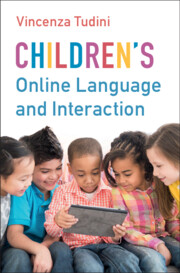Book contents
- Children’s Online Language and Interaction
- Children’s Online Language and Interaction
- Copyright page
- Dedication
- Contents
- Figures and Tables
- Preface
- Acknowledgements
- Transcription Conventions
- 1 What Is Talk and Why Do Children Need It?
- 2 Beyond Emotions: Emoji Talk
- 3 Penguin Talk
- 4 Video Game Talk
- 5 Minecraft Interaction
- 6 Children’s YouTube Comments on Ethan Gamer
- 7 Online Grooming Talk
- 8 Summary of Findings, Implications, and Guidelines
- Appendix: Data Table
- References
- Index
4 - Video Game Talk
Published online by Cambridge University Press: 19 December 2024
- Children’s Online Language and Interaction
- Children’s Online Language and Interaction
- Copyright page
- Dedication
- Contents
- Figures and Tables
- Preface
- Acknowledgements
- Transcription Conventions
- 1 What Is Talk and Why Do Children Need It?
- 2 Beyond Emotions: Emoji Talk
- 3 Penguin Talk
- 4 Video Game Talk
- 5 Minecraft Interaction
- 6 Children’s YouTube Comments on Ethan Gamer
- 7 Online Grooming Talk
- 8 Summary of Findings, Implications, and Guidelines
- Appendix: Data Table
- References
- Index
Summary
Based on insights from previous research, Chapter 4 introduces the language and complex interactional structure of video game interaction, including both online and offline elements. While the chapter identifies multiple combinations and configurations of gaming interaction which are available to children, most research studies are focused on co-located collaborative gaming, where children game side by side rather than at a distance. The chapter develops an analytical framework based on conversation analysis principles, which is applicable to most games, and which is the basis for analysis of Minecraft text chat in Chapter 5. This framework considers interactivity as a social rather than technical accomplishment, to assess videogames’ potential to promote children’s learning through interaction. This chapter includes an analysis of the language used when co-present gamers play face-to-face, which reveals that despite its interactional complexity, gaming language is often linguistically limited, as imperative forms, instructions, exclamations and interjections constitute most of the language used by gamers. This language may however be valuable to children for game-related problem solving and relationship building. It is also an opportunity for authentic language practice on specific language learning objectives where gamers are using a second language.
- Type
- Chapter
- Information
- Children's Online Language and Interaction , pp. 78 - 97Publisher: Cambridge University PressPrint publication year: 2025

